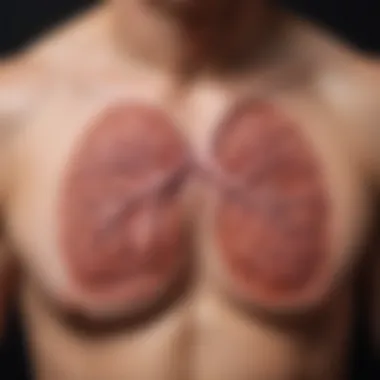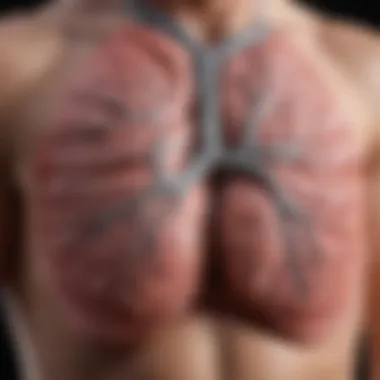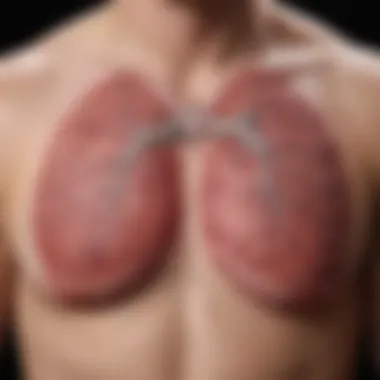Understanding Lung Exacerbation: Definitions and Implications


Intro
Lung exacerbations represent a critical area of concern in respiratory health. The term refers to a significant worsening of respiratory symptoms, which can arise from various underlying conditions. These exacerbations can lead to hospital visits, increased morbidity, and a notable decrease in quality of life for patients. Understanding the nuances of these events is vital for healthcare practitioners, patients, and researchers alike.
In this article, we will dissect the concept of lung exacerbation in detail. We will explore its definitions, triggers, symptoms, and management strategies, all of which play a pivotal role in chronic respiratory diseases. The aim is to provide a thorough synthesis of existing knowledge and highlight the ongoing research directions in treatment and prevention.
By delving into these elements, we hope to enhance the reader’s understanding of lung exacerbation and its broader implications for respiratory health. This exploration highlights the importance of recognizing exacerbations and managing them effectively to improve patient outcomes.
Lung Exacerbation Defined
Lung exacerbation is a critical aspect of respiratory health that warrants thorough exploration. Understanding the definitions and implications surrounding this concept is essential for multiple stakeholders, including healthcare providers, patients, and researchers. An exacerbation can lead to acute declines in lung function and significantly impact individuals' quality of life. By comprehensively discussing how an exacerbation is defined clinically, its pathophysiological aspects, and common terminology, we can lay a foundation for better management strategies and enhanced patient outcomes.
Clinical Definition
Clinically, a lung exacerbation is characterized by a noticeable worsening of respiratory symptoms. This includes increased breathlessness, coughing, sputum production, and changes in sputum color or consistency. It is commonly associated with chronic respiratory diseases, such as chronic obstructive pulmonary disease (COPD) and asthma. The criteria for defining an exacerbation may differ across these conditions, but it fundamentally indicates a deterioration in lung health that requires prompt medical attention. These episodes can arise suddenly or gradually worsen over time and often necessitate changes in treatment or hospitalization for severe cases.
Pathophysiological Aspects
The pathophysiology of lung exacerbations is complex and involves various mechanisms at the cellular and molecular levels. In chronic conditions, such as COPD, exacerbations are often linked to inflammation in the airways, leading to increased mucus production and airway narrowing. Viral and bacterial infections frequently act as precipitants, triggering inflammatory responses that further compromise lung function. Additionally, environmental factors such as pollution and allergens can exacerbate these responses. Understanding these underlying aspects helps healthcare practitioners plan appropriate interventions and preventative strategies to mitigate future exacerbations.
Common Terminology
In the discourse of lung exacerbation, common terminology often includes terms like "acute exacerbation" and "chronic exacerbation." Acute exacerbations refer to sudden and severe worsening of symptoms, often requiring immediate medical intervention, whereas chronic exacerbations indicate a more gradual decline over time. Other important terms include "trigger" (the event or condition that precipitates an exacerbation), "remission" (a period of symptom relief), and "comorbidity" (the presence of additional health conditions that may influence the management of lung problems). Utilizing correct terminology is crucial for clear communication among healthcare providers and helps ensure that patients receive the most effective care.
Types of Lung Exacerbations
Understanding the various types of lung exacerbations is crucial for effective management and treatment of respiratory diseases. Distinguishing between acute and chronic exacerbations allows healthcare professionals to tailor interventions based on timing and underlying conditions. This difference can influence treatment plans and inform patients about their conditions. Properly recognizing and categorizing exacerbations can help in minimizing complications and improving quality of life.
Acute Exacerbation
Acute exacerbations are characterized by a sudden worsening of respiratory symptoms, which requires immediate attention. These events can result from various causes such as infections, environmental factors, or sudden changes in the weather. Patients may present with increased cough, wheezing, or shortness of breath.
The clinical significance of acute exacerbations lies in their potential to lead to hospitalization. In chronic obstructive pulmonary disease (COPD), for example, a single acute event might trigger a decline in lung function. Timely intervention is critical during these episodes to prevent further deterioration and to manage symptoms effectively.
Chronic Exacerbation
Chronic exacerbations occur more gradually, often over days or weeks. These are commonly associated with chronic respiratory diseases, where the baseline respiratory function is continually compromised. Patients may experience a slow escalation of symptoms such as persistent cough, increased sputum production, and worsening breathlessness.
Identifying chronic exacerbations is vital for adjusting ongoing management strategies. These exacerbations may be exacerbated by gradual exposure to environmental triggers or by lifestyle factors such as smoking. Recognizing chronic exacerbation patterns can help in proactive disease management, reducing future risks.
Differential Diagnosis
Differential diagnosis is an essential process in evaluating lung exacerbations. Not all respiratory symptoms stem from the same underlying cause, and misdiagnosis can lead to inappropriate management. Healthcare practitioners must differentiate between exacerbations caused by infections, allergic reactions, or other health complications like heart failure.
A comprehensive assessment often includes patient history, clinical examination, and diagnostic tests. Some key considerations may include:
- Symptoms Duration: Assessing how long symptoms have persisted can guide in identifying exacerbation type.
- Patient History: Knowledge of the patient's previous lung conditions and medication adherence is crucial.
- Diagnostic Imaging: Chest X-rays or CT scans can help identify structural changes or infections.
- Laboratory Tests: Checking for pulmonary infection markers through blood tests can assist in determining the appropriate treatment.
Ultimately, accurate differential diagnosis is vital for optimizing treatment strategies, preventing unnecessary hospitalization, and improving patient outcomes.


Causes and Triggers
Understanding the causes and triggers of lung exacerbations is crucial for effective management and prevention. Identifying these factors can help in tailoring treatment and avoiding potential worsening of respiratory health. This section will analyze the contributory elements under various categories, providing a clear overview of how these factors influence exacerbations.
Environmental Factors
Environmental factors play a significant role in lung health and the frequency of exacerbations. Pollution, allergens, and weather conditions can act as triggers. Common pollutants include particulate matter, ozone, and various industrial emissions. These environmental agents can induce inflammation in the airways, leading to exacerbated symptoms.
- Air Quality: Poor air quality can lead to increased hospital visits for patients suffering from respiratory conditions. Initiatives aimed at improving air quality could significantly affect exacerbation rates.
- Temperature Changes: Extreme temperatures, both cold and hot, can cause respiratory issues. For example, cold air can constrict airways, while heat may lead to dehydration and increased mucus production.
- Pollen and Allergens: Seasonal allergies can worsen lung conditions. Avoiding exposure during high pollen days is often recommended for sensitive individuals.
"The environment has a profound impact on respiratory health, underscoring the need for constant monitoring and pollution control."
Infectious Agents
Infectious agents are another prominent cause of lung exacerbation. Bacterial and viral infections can lead to acute exacerbations, often characterized by increased cough, sputum production, and dyspnea.
- Viral Infections: Influenza and respiratory syncytial virus (RSV) are common culprits in patients with underlying lung diseases. Vaccination against certain viral infections can be a preventative strategy.
- Bacterial Infections: Streptococcus pneumoniae and Haemophilus influenzae are frequently associated with exacerbation. Prompt antibiotic treatment can mitigate severe outcomes.
- Fungal Infections: In some patients with weakened immunity, fungi like Aspergillus can also cause exacerbations, particularly in a mold-rich environment.
Lifestyle and Behavioral Factors
Lifestyle and behavioral factors are critical in understanding lung exacerbations. Certain habits can either exacerbate or alleviate symptoms. Behavioral adjustments are often necessary to manage risks effectively.
- Smoking: Tobacco smoke is one of the leading causes of chronic obstructive pulmonary disease (COPD) exacerbations. Quitting smoking can considerably reduce the risk of future exacerbations.
- Physical Activity: Engaging in regular physical activity, when done safely, can strengthen the respiratory system. However, high-intensity activities might trigger symptoms for some patients, particularly during an exacerbation.
- Medication Adherence: Inconsistent use of prescribed inhaled medications can lead to increased frequency of exacerbations. Education on correct inhaler techniques is essential for success.
In summary, the multifactorial nature of lung exacerbations necessitates a thorough understanding of these causes and triggers. Proper management strategies derived from this knowledge can lead to improved patient health and quality of life.
Symptoms of Lung Exacerbation
Understanding the symptoms associated with lung exacerbation is crucial for timely intervention and management. The recognition of these symptoms allows healthcare providers and patients to respond effectively, potentially diminishing the severity of the exacerbation. Symptoms can vary significantly among individuals, influenced by factors like the underlying disease and the patient's baseline health status. Moreover, understanding these symptoms helps in tailoring management strategies and improving the quality of life for patients.
Respiratory Symptoms
Respiratory symptoms represent the most immediate and critical indicators of lung exacerbation. These symptoms often encompass increased breathlessness, wheezing, and coughing. In some cases, the patient may experience chest tightness as the airways become inflamed or constricted.
- Increased Breathlessness: Patients may find simple tasks like walking or climbing stairs to be more exhausting than usual. This can be distressing and can lead to reduced mobility, further deteriorating their condition.
- Wheezing: It is often a sign of narrowed air passages and may indicate bronchospasm or inflammation. Patients or caregivers should be aware that the presence of wheezing often suggests an urgent need for intervention.
- Coughing: Increased frequency or severity of coughing can indicate an exacerbation. This may include a productive cough that brings up mucus, or a dry persistent cough. Monitoring the characteristics of the cough can provide valuable information about the underlying issues.
Systemic Symptoms
While respiratory symptoms are paramount, systemic symptoms should not be overlooked. These symptoms can provide insight into the overall impact of the exacerbation on the patient's body. Patients may experience:
- Fatigue: A general feeling of tiredness can often be present due to the exertion of breathing and inadequate oxygen exchange.
- Fever: This can indicate an underlying infection, which can often trigger exacerbations in individuals with chronic lung disease.
- Increased Heart Rate: Also known as tachycardia, this can be a compensatory mechanism as the body seeks to maintain adequate oxygen delivery to tissues.
Recognizing systemic symptoms aids in understanding the broader physiological implications of the exacerbation, and it can guide further investigations and treatments.
Variation Among Diseases
It is important to note that symptoms of lung exacerbation can differ based on the underlying condition. For example:
- Chronic Obstructive Pulmonary Disease (COPD): Patients may experience significant wheezing and increased sputum production during exacerbations.
- Asthma: Symptoms often include acute wheezing and shortness of breath, particularly following exposure to triggers such as allergens or cold air.
- Interstitial Lung Disease: Those with this condition may experience more pronounced systemic symptoms and a gradual decline in respiratory capacity during exacerbations.


Thus, understanding these variations helps in the assessment and management of lung exacerbation. The approach to treatment and monitoring must be tailored to the specific type of lung disease affecting the patient.
Monitoring symptoms closely can lead to timely interventions that significantly improve patient outcomes.
Through thoughtful recognition of symptoms, healthcare providers can better manage lung exacerbations, leading to improved patient experiences and health outcomes.
Diagnosis of Lung Exacerbation
Diagnosing a lung exacerbation is critical for effective management and treatment. An accurate diagnosis allows healthcare providers to identify the severity of the condition, tailor treatments, and ultimately improve patient outcomes. The process relies heavily on clinical evaluations, diagnostic tests, and assessment tools. Each element plays a vital role in gathering information about the patient's health status and understanding the complexity of lung exacerbations.
Clinical Evaluation
Clinical evaluation forms the first step in diagnosing lung exacerbation. This process typically includes a thorough history-taking and physical examination. Healthcare professionals look for signs and symptoms that may indicate an exacerbation, such as:
- Increased breathlessness
- Worsening cough
- Sputum production changes
- Fevers or chills
During the evaluation, practitioners will consider the patient's medical history, including previous exacerbations and any existing chronic pulmonary conditions, such as chronic obstructive pulmonary disease (COPD) or asthma. Documenting medication use, adherence, and environmental exposures is crucial since these factors can influence the exacerbation severity. Thus, a detailed clinical evaluation is essential to formulating a treatment plan that addresses not just the exacerbation but also its underlying causes.
Diagnostic Tests
Once the clinical evaluation is complete, diagnostic tests act as a means to confirm the presence and extent of the exacerbation. Commonly used tests include:
- Spirometry: Measures lung function, helping to assess airflow obstruction.
- Peak flow measurements: Indicates lung function changes that occur during exacerbations.
- Chest X-rays: Allows visualization of lung structures and identification of pneumonia or other complications.
- Blood tests: Can reveal signs of infection or inflammatory responses.
- Sputum cultures: Useful in identifying infectious agents if bacterial infection is suspected.
These tests provide valuable data that can guide treatment decisions. For instance, if a bacterial infection is confirmed through sputum analysis, antibiotics may be initiated. The timely use of diagnostic tests contributes significantly to refining management strategies and ensuring better health outcomes.
Assessment Tools
Assessment tools also play an important role in the diagnosis process. These tools help quantify the severity of symptoms and patient impact. Common assessments include the Modified Medical Research Council (mMRC) dyspnea scale and the COPD Assessment Test (CAT). Each of these tools provides a structured method to evaluate patient status.
By using these guidelines, healthcare providers can monitor symptom progression and adjust treatment when necessary. Furthermore, regular assessments may reveal patterns that assist in predicting future exacerbations, leading to proactive management.
Accurate diagnosis, supported by clinical evaluation, diagnostic tests, and assessment tools, empowers healthcare professionals to tackle lung exacerbations effectively, guiding patients toward improved respiratory health. Understanding and appropriately diagnosing exacerbations offer a pathway to better enduring outcomes and enriched quality of life.
Management Strategies
Effective management strategies for lung exacerbation are critical in optimizing patient outcomes. An exacerbation can lead to increased morbidity, hospitalizations, and a decline in quality of life. Therefore, understanding and employing appropriate management strategies can mitigate these adverse effects. This section covers pharmacological treatments, non-pharmacological approaches, and preventive strategies. Each element is essential in creating a comprehensive care plan for individuals experiencing lung exacerbations.
Pharmacological Treatments
Pharmacological treatments play a vital role in managing lung exacerbations. These medications are often designed to alleviate acute symptoms and restore optimal lung function. Common classes of drugs include bronchodilators like albuterol, inhaled corticosteroids, and antibiotics for infections. The choice of medication depends on the severity of the exacerbation and the underlying lung condition.
For instance, bronchodilators help relax bronchial muscles, improving airflow and reducing shortness of breath. Inhaled corticosteroids reduce inflammation in the airways, providing relief from symptoms. Antibiotic therapy becomes crucial if bacterial infections trigger the exacerbation. Regular use of these medications can prevent frequent flare-ups, improving the patient's overall respiratory health.
It is crucial for patients to work closely with healthcare providers to tailor a pharmacological regimen that aligns with their specific needs and health status.
Non-Pharmacological Approaches
Non-pharmacological approaches are complementary to medication-based treatments for lung exacerbation management. These methods focus on lifestyle modifications and behavioral changes that can enhance lung function and overall well-being.


Some effective non-pharmacological strategies include:
- Pulmonary Rehabilitation: This structured program encompasses exercise training, education, and support to help patients manage their condition. It leads to improved physical endurance and a better understanding of the disease.
- Nutritional Support: A balanced diet is crucial for maintaining energy levels and overall health. Proper nutrition can aid in recovery and enhance immune function.
- Smoking Cessation: For smokers, quitting is the most significant step toward managing lung health. Various resources, including counseling and nicotine replacement therapies, are available to help patients quit smoking.
These approaches foster a more holistic path to managing lung health, ultimately reducing the frequency and severity of exacerbations.
Preventive Strategies
Preventive strategies are essential in minimizing the risk of lung exacerbations. Awareness and proactive measures can significantly influence long-term lung health. Key preventive strategies include:
- Vaccinations: Immunizations against influenza and pneumonia can reduce the likelihood of respiratory infections that trigger exacerbations.
- Monitoring: Regular monitoring of lung function through spirometry helps identify early signs of deterioration, allowing for timely intervention.
- Allergen Avoidance: Identifying and avoiding allergens can help in reducing exacerbation frequency. This may involve maintaining indoor air quality and avoiding known allergens in the environment.
Preventive strategies are vital in managing lung exacerbations. They empower patients to take control of their health, leading to improved outcomes and a better quality of life.
Impact on Quality of Life
The concept of lung exacerbation has significant implications for quality of life. Not only does it affect physical health, but it also has far-reaching effects on psychological well-being. Understanding these impacts is essential for healthcare providers, patients, and researchers alike.
Physical Health Considerations
Lung exacerbations can profoundly influence physical health. They often lead to increased respiratory symptoms such as wheezing, shortness of breath, and mucus production. These symptoms can severely limit physical activity. Patients may find it challenging to perform daily tasks, which can lead to a sedentary lifestyle. In turn, decreased physical activity can contribute to weight gain, reduced muscle strength, and other health complications. Furthermore, frequent exacerbations can escalate the progression of chronic respiratory diseases, resulting in longer recovery times and heightened healthcare needs.
Psychosocial Effects
The psychosocial effects of lung exacerbations must not be overlooked. Individuals with chronic respiratory conditions often experience anxiety and depression, which can be exacerbated during an episode. The fear of not being able to breathe or the unpredictability of exacerbations can create a cycle of stress. Social interactions may diminish as individuals avoid situations where they might struggle to breathe. This can lead to feelings of isolation and decreased overall life satisfaction. Support systems become critical, as emotional well-being is linked closely to the management of chronic conditions.
Long-term Consequences
Long-term consequences of lung exacerbations are multifaceted. Chronic exacerbations can lead to progressive lung damage, affecting lung function over time. This may result in increased morbidity and mortality in some cases. Patients may also experience frequent hospitalizations, leading to increased healthcare costs and disruption of their lives. Moreover, as lung function deteriorates, dependency on caregivers often increases. The increase in long-term care requirements can also weigh heavily on family members, creating a broader social impact.
Living with chronic respiratory conditions is challenging, and understanding the implications of exacerbations is vital for improving patient outcomes.
To summarize, the impact of lung exacerbation extends beyond immediate health issues. It significantly affects physical capabilities, psychological well-being, and long-term health trajectories. Addressing these factors comprehensively can improve overall life quality for individuals living with lung exacerbations.
Current Research Trends
Research on lung exacerbation is evolving and it plays an essential role in respiratory health. Understanding current research trends helps to identify ongoing developments in treatment, diagnosis, and public health strategies. The insights gained are crucial for improving outcomes for patients with chronic respiratory conditions.
Emerging Therapies
Recently, there has been a shift toward developing novel therapies aimed at mitigating the impacts of lung exacerbations. This includes biologic agents that target specific pathways involved in airway inflammation. One such therapy is mepolizumab, which is being widely researched for its effectiveness in patients with severe asthma. Current studies focus on refining patient selection to ensure the right individuals benefit maximally from such therapies. This research not only strives for effectiveness but also looks into personalized medicine approaches, where therapies are tailored to the individual.
Health practitioners can find substantial promise in these emerging therapies because they may offer alternatives where standard treatments have failed. Moreover, understanding such advancements contributes to better patient education, which is a vital part of the management process.
Innovative Diagnostic Methods
The advancement in diagnostic technologies is another significant trend. Traditionally, the diagnosis of lung exacerbations relied heavily on clinical assessments and basic imaging. Now, researchers are exploring more advanced diagnostic tools such as biomarkers and advanced imaging techniques like high-resolution computed tomography (HRCT).
Biomarkers can provide objective data that can signal exacerbation events before they become severe. For instance, studies are looking at specific eosinophil counts and other inflammatory markers. These methods could transform how clinicians approach diagnosis and lead to earlier intervention, which is a key factor in managing exacerbations effectively.
Public Health Implications
Finally, the public health aspects of lung exacerbation research cannot be overlooked. Understanding the prevalence and impact of exacerbations on a population level can inform health policies and resource allocation.
For instance, studies have shown a notable correlation between air pollution and an increase in exacerbation events. Identifying such links emphasizes the need for improved regulatory measures regarding environmental factors. Furthermore, public health campaigns aimed at awareness can significantly decrease exacerbation rates, leading to a more informed populace trained to manage their respiratory conditions more effectively.
In summary, the trends in research on lung exacerbation depict a forward-looking landscape that prioritizes personalized medicine, innovative diagnostic tools, and comprehensive public health initiatives. These efforts have the potential to enhance the quality of life for individuals suffering from chronic lung diseases, making it a rich field of study for students, researchers, and healthcare professionals alike.







